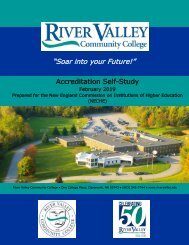You also want an ePaper? Increase the reach of your titles
YUMPU automatically turns print PDFs into web optimized ePapers that Google loves.
CCSNH, however, has one of the strongest dual-credit and dual-enrollment programs in the country,<br />
with more students in dual-credit as a proportion of all new students than any other state. CCSNH<br />
should continue to build on this strength by developing a pipeline of these students to enroll in college<br />
after they graduate from high school. Dual-credit and dual-enrollment programs offered at CCSNH<br />
through collaboration with local high schools include Early College, Running Start, eStart, and CTE.<br />
To recruit all remaining students --- non-CTE, also not in a dual-credit or dual-enrollment program – we<br />
promote the value of our colleges in high schools, including with teachers, parents, counselors,<br />
administrators, and students themselves. CCSNH targets parents primarily through marketing efforts<br />
that make the quality education proposition abundantly clear.<br />
CCSNH administrators and others follow-up with high school counselors, principals, and<br />
superintendents in their catchment area to sit with them and explain the transfer and workforce value<br />
proposition of our Colleges. Also, collaboration with the Commissioner of the Department of Education<br />
has helped tighten partnership with the K-12 system.<br />
Finally, CCSNH is working on attracting more adult learners to our institution. As of February 2018,<br />
New Hampshire has the second-lowest unemployment rate in the country at 2.6 percent – the lowest<br />
being Hawaii at 2.1 percent. Low unemployment is great, but to whatever extent employed workers, in<br />
the aggregate, do not meet 65 by 25 is, in essence, a proxy by which labor growth is hamstrung,<br />
alongside our ability to attract new businesses to the state, and to retain existing ones, despite low<br />
unemployment.<br />
With a decline in the absolute number of young people in the state, even a dramatic uptick in awards<br />
production for the traditional-age college-going population would not move New Hampshire towards 65<br />
by 25. The only way to get there will be by re-engaging adult learners, especially those who presently<br />
work in a low unemployment state. This imperative comes when, across the country, according to data<br />
calculated by the National Student Clearinghouse Research Center, the proportion of undergraduate<br />
students age 24 and over has actually decreased over the last few years as the job market has<br />
improved, at precisely the time New Hampshire and other states need more workers with associate’s<br />
degrees or higher.<br />
The State is trying to get to 65 percent with credentials of economic value in seven years and stands<br />
today at only 50 percent – 10 percent with an associate’s, plus 40 percent with a bachelor’s or higher.<br />
This number excludes certificate achievers, which CCSNH estimates as another three percentage<br />
points out of the “Some College” segment below.<br />
NH Educational Attainment by Age Group, 20<br />
183 | P a g e





